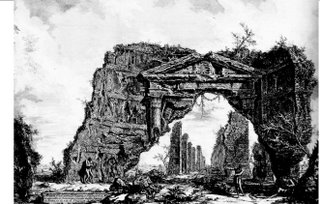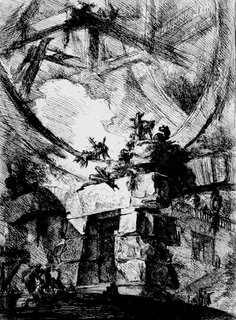Today suKOH's afternoon class (Theories of Interior Architecture) was quite interesting though the fact I was quite sleepy after lunch. Last week was about this Classicism Era guy - Leon Battista Alberti who is the first man who wrote the first 10 books on The Art of Building 1442 - 1452 & Theories on How to build Buildings. Some of this works such as Tempio Malatestiano, Rimini (1446); Arch of Constantine; Sta. Maria Novella, Florence (1458) & etc. Was interesting but wasn't that attention-grabbing than today's topic Romantic Era man - Giovanni Battista Piranesi. For me, at least.
Rome through the Eyes of the Wicked Architect
He was the architect who devoted his entire life to drawings instead of building
Why was he important?
Most outspoken architectural polemicist who believed absolutely in the supremacy of Roman over Greek Architecture (Pro-Roman vs. NeoClassisist)
Why was he important?
Most outspoken architectural polemicist who believed absolutely in the supremacy of Roman over Greek Architecture (Pro-Roman vs. NeoClassisist)
Giovanni Battista Piranesi was a major Italian printmaker, architect and antiquarian. The son of a Venetian master builder, he studied architecture and stage design, through which he became familiar with Illusionism.
(my first glance when suKoh show us.. I thought he looked like Mr. Bean.. hehe)
Reality vs. Fantasy. “Campo Marzio”
a. Familiar classical shapes & forms -eg. Centralized objects, piazzas, porticoes, circuses, baths, axes and symmetry all arranged in a logic of the ancient Roman way.
b. Mausoleo Andriano / Hadrians mausoleum – but the surroundings, don’t exist.
c. Deliberately depicting his subject in accurately.
d. As a antiquarian/archaeologist,
e. Documentation and Recomposing a city or parts of a city through the understanding of ancient forms, - inventive, imaginative,
f. His work bounces between reality and fantasy.
a. Familiar classical shapes & forms -eg. Centralized objects, piazzas, porticoes, circuses, baths, axes and symmetry all arranged in a logic of the ancient Roman way.
b. Mausoleo Andriano / Hadrians mausoleum – but the surroundings, don’t exist.
c. Deliberately depicting his subject in accurately.
d. As a antiquarian/archaeologist,
e. Documentation and Recomposing a city or parts of a city through the understanding of ancient forms, - inventive, imaginative,
f. His work bounces between reality and fantasy.
Antichita Romane & Vedute di Roma (‘Un-Romantic’)
a. Miniscule Human Figures – tiny people, in comparison to the buildings, magnifies and exaggerates the monuments, part of the glorification of the ancient architecture
b. Overgrowth of Vegetation. Enormous scale, overpowering the ruins and human figures. Nature taking over humanity or our built environment are subject to time and natural forces – Helplessness.
c. Birds Eye View; exaggerate the grandeur of the monuments – glorification
d. Un-Romantic- In comparison to his contemporaries, one that paints a more accurate depiction of the current social and political condition.
This schism between Reality and Fantasy, is the main ingredient in Piranesi’s work.
a. Miniscule Human Figures – tiny people, in comparison to the buildings, magnifies and exaggerates the monuments, part of the glorification of the ancient architecture
b. Overgrowth of Vegetation. Enormous scale, overpowering the ruins and human figures. Nature taking over humanity or our built environment are subject to time and natural forces – Helplessness.
c. Birds Eye View; exaggerate the grandeur of the monuments – glorification
d. Un-Romantic- In comparison to his contemporaries, one that paints a more accurate depiction of the current social and political condition.
This schism between Reality and Fantasy, is the main ingredient in Piranesi’s work.
Beneath the surface of exaltation and glorification, one finds a different side depicting the longing or reminiscent of the architect for the past, subliminally suggesting the sense of dark, melancholy, despair and hopelessness. This irony opens up a discussion of what these etchings or drawings mean. Through his works, we will discover a schism that continually plays in Piranesi’s work that bounces between reality and fantasy, one that suggest the thought of negative thinking.
Le Carceri. (The Prisons)
The observer’s point of view is not from an ‘exterior’ view, but rather an ‘interior’ view. The observer is in Prison himself.
Sigh.. By doing more researches on him myself & with suKoh's clear explanation & elaboration, I really find this guy very interesting. I mean, his whole life, he was so devoted to all his drawings rather than buildings. And I really like the way he draw though his stle was more on negativity, the dark side, evil & scary. If you observe nicely, most of his drawings in his drawings are framed. Well, there was a reference on his works - VIDEO: Yo Yo Ma Inspired by Bach, The Second Cello Suite. Cool.






No comments:
Post a Comment